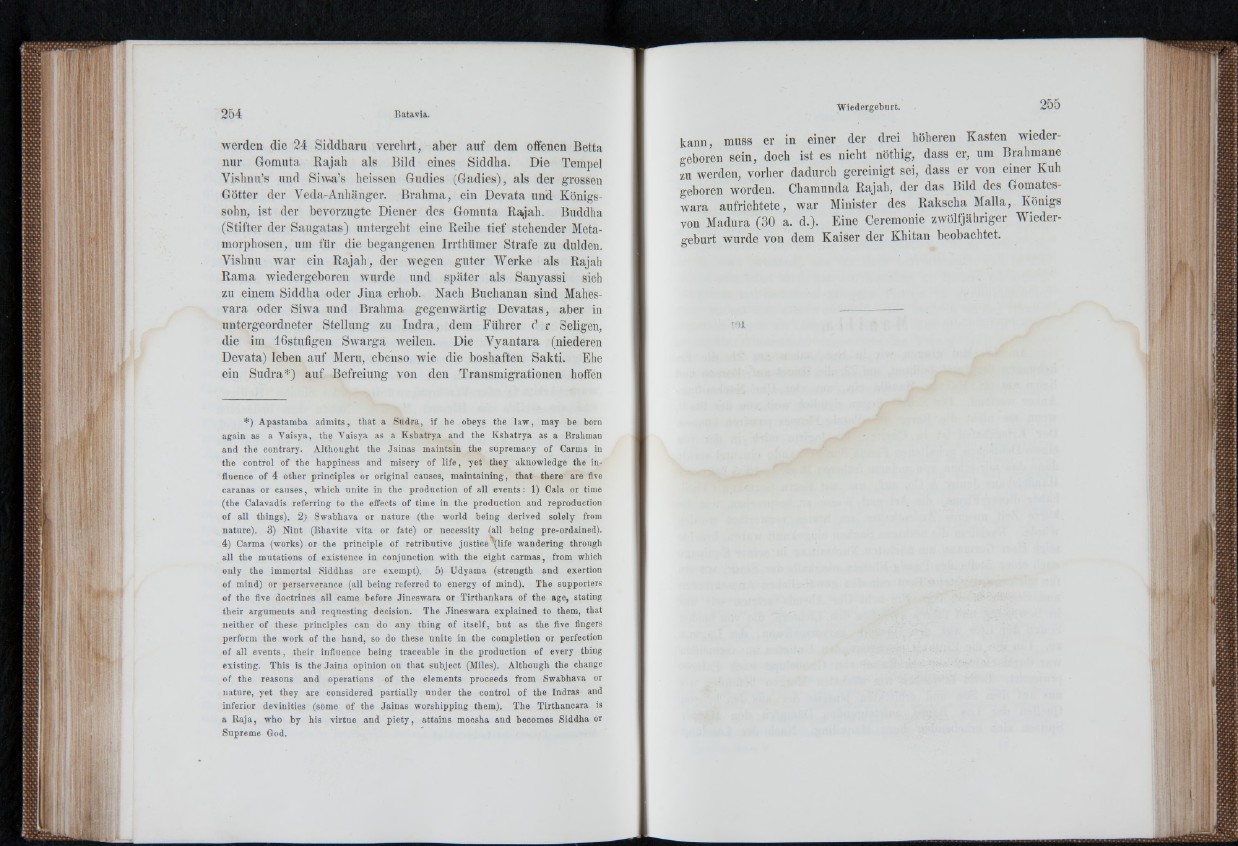
werden die 24 Siddharu verehrt, aber auf dem offenen Betta
nur Gomuta Rajah als Bild eines Siddha. Die Tempel
Vishnu’s und Siwa’s heissen Gudies (Gadies), als der grossen
Götter der Veda-Anhänger. Brahma, ein Devata und Königssohn,
ist der bevorzugte Diener des Gomuta Rajah. Buddha
(Stifter der Saugatas) untergeht eine Reihe tief stehender Metamorphosen,
um für die begangenen Irrthümer Strafe zu dulden.
Vishnu war ein R ajah , der wegen guter Werke als Rajah
Rama wiedergeboren wurde und später als Sanyassi sich
zu einem Siddha oder Jina erhob. Nach Buchanan sind Mahes-
vara oder Siwa und Brahma gegenwärtig Devatas, aber in
untergeordneter Stellung zu In d ra , dem Führer d r Seligen,
die im 16stufigen Swarga weilen. Die Vyantara (niederen
Devata) leben auf Meru, ebenso wie die boshaften Sakti. Ehe
ein Sudra*) auf Befreiung von den Transmigrationen hoffen
*) Apastamba admits, that a Sudra, if he obeys the law , may be born
again as a Vaisya, the Vaisya as a Kshatrya and the Kshatrya as a Brahman
and the contrary. Althought the Jainas maintain the supremacy of Carma in
the control of the happiness and misery of life , yet they aknowledge the influence
of 4 other principles or original causes, maintaining, that there are five
caranas or causes, which unite in the production of all events: 1) Cala or time
(the Calavadis referring to the effects of time in the production and reproduction
of all things). 2) Swabhava or nature (the world being derived sole ly from
nature). 3) Nint (Bhavite vita or fate) or necessity (aU being pre-ordained).
4) Carma (works) or the principle of retributive justice qlife wandering through
all the mutations of existence in conjunction with the eight carmas, from which
only the immortal Siddhas are exempt). 5) Udyama (strength and exertion
of mind) or perserverance (all being referred to energy of mind). The supporters
of the five doctrines all came before Jineswara or Tirthankara of the age, stating
their arguments and requesting decision. The Jineswara explained to them, that
neither of these principles can do any thing of itself, but as the five Angers
perform the work of the hand, so do these unite in the completion or perfection
of all events, their influence being traceable in the production of every thing
existing. This is the Jaina opinion on that subject (Miles). Although the change
of the reasons and operations of the elements proceeds from Swabhava or
nature, yet they are considered partially under the control of the Indras and
inferior devinities (some of the Jainas worshipping them). The Tirthancara is
a Raja, who by his virtue and p ie ty , attains mocsha and becomes Siddha or
Supreme God.
kann, muss er in einer der drei höheren Kasten wiedergeboren
sein, doch ist es nicht nöthig, dass er, um Brahmane
zu werden, vorher dadurch gereinigt sei, dass er von einer Kuh
geboren worden. Chamunda Rajah, der das Bild des Gomates-
wara aufrichtete, war Minister des Rakscha Malta, Königs
von Madura (30 a. d.). Eine Ceremonie zwölfjähriger Wiedergeburt
wurde von dem Kaiser der Khitan beobachtet.
toi